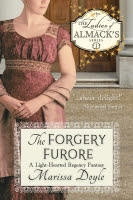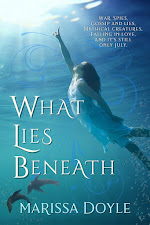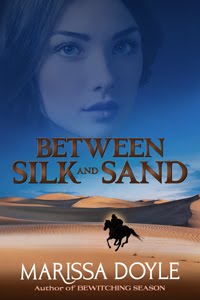As I have in previous posts, I’ll be examining actual fabric samples glued into
several earlier editions of Ackermann’s Repository, samples supplied by
the manufacturers and published by Ackermann in order to boost the British
cloth-making industry at a time when exporting British goods to Europe was
almost impossible because of the Napoleonic war. I'll give you a close-up scan
of each sample, the published description if available, and my own observations
of the color, weight, condition, and similarity to present-day materials, to
give you as close a picture as possible of what these fabrics are like.
Today’s three samples are from
the April 1812 issue of Ackermann’s Repository.
The overall condition of my copy is excellent; the page itself is free of foxing
and is only slightly toned; one of the samples shows some foxing and another some
toning, but overall they’re in very good condition.
Here we go!
No. 1 and 2. An elegant and unique pattern, resembling tambour work,
for gentlemen’s waistcoats, associating most pleasingly and happily with the
puce or blue riding-coat. This truly spring-like and fashionable article is now
in great request; and several members of the Whip Club have lately
distinguished themselves by double-breasted waistcoats of this attractive
article. It is furnished by Messrs. Maund and Co. wholesale and retail men’s-mercers,
Cornhill; a house most justly celebrated for taste and variety in stuffs and
manufactures for ladies’ habits, as well as gentlemen’s attire.
We are sorry that we could not, in this number, introduce another very
elegant and chaste pattern from the same respectable house; but, as it is
calculated for either winter or summer, we shall give it in out next number.
My comments: This is a heavy, very sturdy twill-woven fabric,
probably of cotton, printed with stylized flowery things...though I shudder to
think of this print paired with a puce riding coat!
No. 3. A cerulean blue imperial gauze, calculated for evening or dinner
parties. Dresses of this article are usually constructed plain, and with little
superficial decoration; they are worn over a white sarsnet or satin slip.
Thread lace, white beads, or swansdown (when seasonable) are its usual
ornaments. It is furnished by Mr. Wm. King, silk mercer, 44, Pall-Mall.
My comments: Very dainty stripes of solid and net weaving, in a
lustrous pale blue silk, very smooth; I can’t (unfortunately) discern if this
pale color is original, or if it has faded from a more intense hue. Very pretty
in an evening dress.
No. 4. A most delicately printed cambric for morning or domestic wear.
Robes of this article are usually formed in plain high dresses, or Grecian
wraps, with no other ornament than a high plaited ruff, or Armenian collar, or
muslin or lace. –This article is sold by Messrs. Hodgkinson & Co. 91, New
Bond-street.
My comments: More quilting fabric! ;) This is a tightly woven
cotton with nice even threads and good quality printing, with only a little bit
of bleed on the colors. The tight weave means the fabric is sufficiently opaque
to not require an underdress or slip.
What do you think of this
month’s fabrics?









3 comments:
I love the blue fabric and really like the last one. I think the colors have faded a bit. Natural dyes don't last as long as chemical dyes but those hadn't been invented yet. Thank you again for sharing these detailed descriptions. It helps enormously when trying to make an authentic reproduction costume. Being a historian, I tend to get anal about details.
I like #3 but I think I would prefer it if it was a more intense blue. Neither of the prints speak to me.
Glad you like these posts, QNPoohBear! I love writing them, as a quilter and sewer.
I'm sure the blue has faded; most texts I've seen referring to cerulean blue seem to indicate a medium blue. But this was still pretty fabric--the alternating stripes of solid weave and net give it an ethereal feeling.
Daisy, I'm not a big fan of the prints either--but it amuses the heck out of me how much some of them resemble vintage quilt fabric from the thirties and forties!
Post a Comment